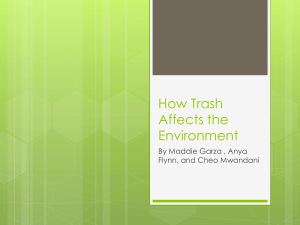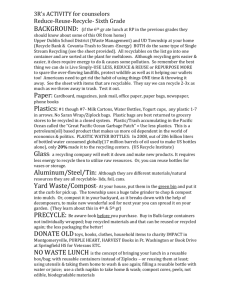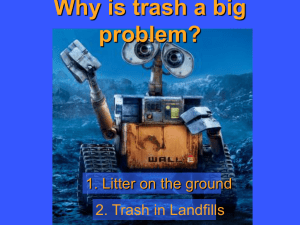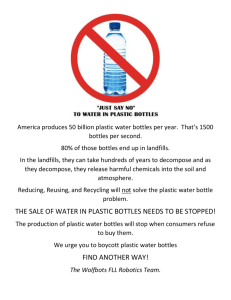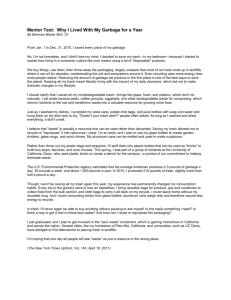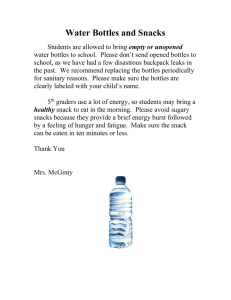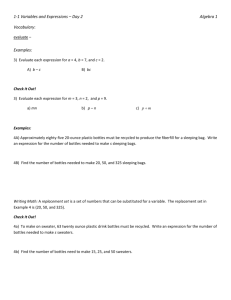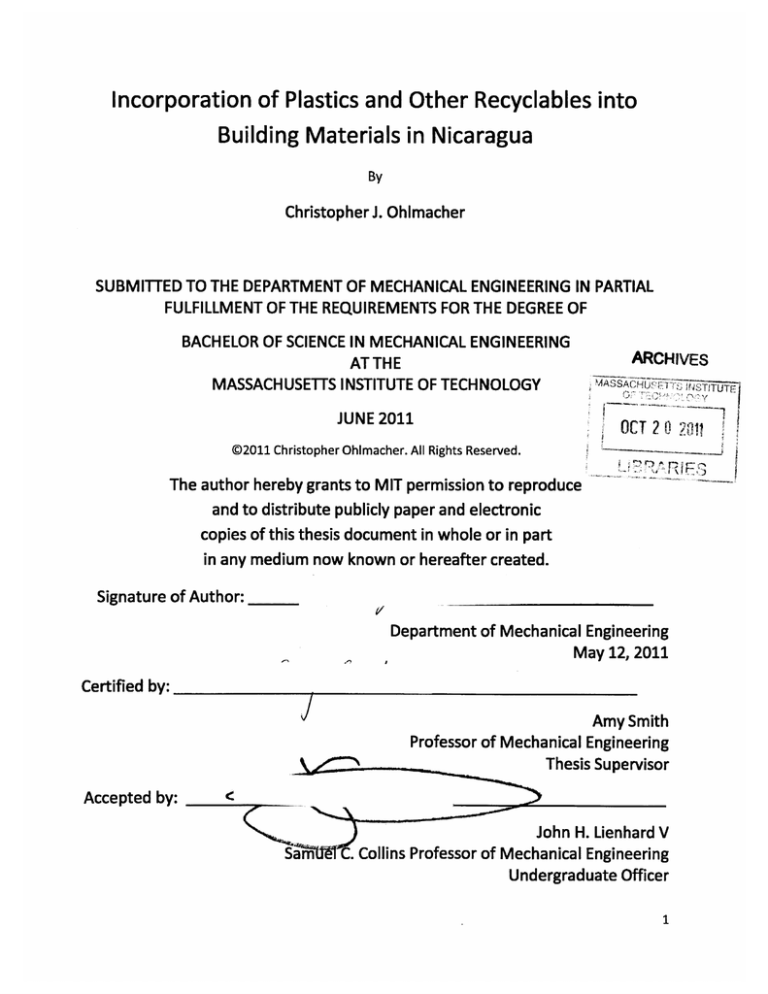
Incorporation of Plastics and Other Recyclables into
Building Materials in Nicaragua
By
Christopher J.OhImacher
SUBMITTED TO THE DEPARTMENT OF MECHANICAL ENGINEERING IN PARTIAL
FULFILLMENT OF THE REQUIREMENTS FOR THE DEGREE OF
BACHELOR OF SCIENCE IN MECHANICAL ENGINEERING
AT THE
MASSACHUSETTS INSTITUTE OF TECHNOLOGY
JUNE 2011
ARCHIVES
MAssATI
OCT 2 0 21
@2011 Christopher Ohimacher. All Rights Reserved.
The author hereby grants to MIT permission to reproduce
and to distribute publicly paper and electronic
copies of this thesis document in whole or in part
in any medium now known or hereafter created.
Signature of Author:
Department of Mechanical Engineering
May 12, 2011
Certified by:
Amy Smith
Professor of Mechanical Engineering
Thesis Supervisor
Accepted by:
Sam
John H. Lienhard V
.M
Collins Professor of Mechanical Engineering
Undergraduate Officer
r
Table of Contents
Introduction......................................................................................................
4
Background........................................................................................................
5
Evaluation of Designs..........................................................................................
9
Pura Vida W all Design .....................................................................................
15
Experim ental Design ........................................................................................
17
Design Implications..........................................................................................
21
Dissem ination .................................................................................................
25
Conclusion ........................................................................................................
25
Works Cited ...........................................................................
29
Incorporation of Plastics and Other Recyclables into
Building Materials in Nicaragua
by
Christopher J. Ohimacher
Submitted to the Department of Mechanical Engineering
on May 12, 2011 in Partial Fulfillment of the
Requirements for the Degree of Bachelor of Science in
Mechanical Engineering
For three communities in Nicaragua: Bluefields, Little Corn Island, and Corn Island,
incentives are needed to motivate residents to not burn their trash and recyclables. There are
various methods that could encourage recycling and garbage collection, although not all are
appropriate for this particular community. After evaluating various project ideas, it was
determined that incorporating recyclables into building materials would be a promising method
for getting use out of the recyclables.
Various processes for incorporating plastic into building materials were evaluated. The
Pura Vida wall used in Guatemala offers a promising building design to encourage residents of
these Nicaraguan communities to utilize their plastic bottles and bags. The wall frame and
foundation are made of concrete and wood, but the majority of the wall's volume is composed of
trash and plastic bottles. Pending further research, this design could possibly be altered for use
in the walls of fixed-dome biogas digesters. A dissemination plan has been formed to test these
designs in the Nicaraguan communities with a local NGO called BlueEnergy.
Thesis Supervisor: Amy Smith
Title: Professor of Mechanical Engineering
Introduction
In Bluefields, Nicaragua and the island communities of Little Corn Island and Corn
Island just off the coast, trash collection presents a significant problem. In some areas, trash
collection occurs on the major roads, of which there are few. Families that are not directly
adjacent to these roads will often burn their trash as a way of disposing it. Furthermore, on the
islands those that have expressed interest in earning profit from recycling products such as
plastic bottles, plastic bags, and cardboard, find that the cost of shipping these items to the
mainland greatly reduces any profit that might be made.
The challenge presented to this community is to develop a way to productively use trash
and recyclables, on the islands themselves, to create value out of them. This will encourage
families to collect and utilize trash and recyclables instead of burning them. In approaching this
problem, we analyzed several different possibilities. The first option examined was to create a
bottle shredder or dry waste compressor to increase the amount of materials that could be
collected along the roads, or shipped off the islands for processing. The Village Green
Recycling Team in the United States has a hand crank baler made from materials that could be
adapted or replaced with materials available in Nicaragua. This baler is used to compact plastics.
The second option was to design a wheelbarrow or cart from local materials that would enable
homes further away from the main road to bring their trash and recyclables to the collection sites.
Third, we looked at ways that the people on Corn Island and Little Corn Island could implement
recyclable materials into locally produced goods such as roofing materials or tote bags.
After a site visit in January of 2011, the site team determined that a lot of building
construction was occurring both in Bluefields and on the islands, and therefore this would be a
good area to focus research. Upon weighing the benefits of several different pre-existing
methods of incorporating recyclables into building materials, the Pura Vida model was selected
as the most promising method for these communities. (Pura Vida) A test model was constructed
at MIT and experiments were done to determine the key design features and seek additional
ideas through the process of building the wall. Design changes were then identified that would
provide flexibility in the use of the wall design in the Nicaraguan communities. A second model
was built incorporating these design changes and the feasibility of these designs was evaluated.
The research into the Pura Vida wall design inspired further ideas of incorporating the design in
biogas digesters in Nicaragua.
Background
For the Nicaraguans with whom we have partnered, the burning of trash and recyclables
presents a challenge for those that want their communities to have a more safe and healthy form
of disposing of waste materials. Our primary community partner is a non-profit organization
called Blue Energy located in Bluefields, Nicaragua. Bluefields is one of five major
municipalities along the eastern coast of Nicaragua. The five municipalities are: Bluefields, The
Corn Islands, Kukra Hill, El Rama, and Pearl Lagoon. Of these municipalities, our focus was on
creating solutions to waste management for Bluefields and The Corn Islands.
Figure 1: Managua, near the western coast, is a main supplier of building materials for Bluefields. (Google Maps)
Figure 2: Corn Island and Little Corn Island are located in the Caribbean Sea, near the town of Bluefields. (Google Maps)
In January, 2011 a site visit was made to collect information on the communities. On
Corn Island, there was a small-scale waste management system in place already. The collection
does not sort recyclables from other waste, so no recycling is done on the island. A tractor
hauling a trailer collects trash along the one main road on the island that runs through the
housing communities. This trailer makes two trips a day, working for six hours a day. The
capacity in the trailer is low, and while it usually is packed such that it overflows by one to two
feet, garbage that exceeds the height of the trailer is swept away by the wind. In addition, there
are five housing communities that are not on the main road, with the largest of these
communities containing 200 homes. Unless these residents haul their trash to the main road it is
not collected, so many simply burn their trash in their backyards.
A very different situation exists on Little Corn Island. There are a few hotels to
accommodate the many tourists that vacation on the island. There are eleven drop off points for
recyclables, with the hotels providing nearly half of the recycled materials. The recycled
materials consist of 50% plastic, 25% cans, and 25% other materials including cardboard and
glass. During the site visit, it was observed that there was over 100 pounds of crushed water
bottles that had been collected. Although the materials are supposed to be sorted at the recycling
centers, there currently is no one assigned to the task of sorting so it does not get done. Once
each month a boat takes the recyclables to a mainland recycling center for little profit. The
expectation of community members is that garbage is burned by individuals. No garbage is
collected on the island.
Figure 3: Bottles are collected, but not sorted, on Little Corn Island.
Bluefields, the mainland municipality, is divided into two sub-communities: Canal and
Loma Fresca. Canal contains several sewage canals, so many homes are on stilts to prevent them
from flooding in the rainy season. In Canal, only garbage is collected. The garbage is brought to
a huge landfill located over top a creek. Two tractors collect the trash along the main roads and
bring the trash to the dump. Those that do not live near the main roads do not burn their trash,
because of the moist environment. Instead, they throw their trash into the bay. Loma Fresca is a
hilly area with no garbage collection. All trash is either burned or thrown into the water. In all
of these communities, metal and glass are usually collected and saved by individuals. These
materials have value within the community and therefore will be sold or traded.
Figure 4: In Canal, many of the houses are built on stilts to last through the months of flooding.
Blue Energy is a non-profit organization located in Bluefields, Nicaragua. (BlueEnergy
Nicaragua) Their focus is providing power generation from windmills. However, the volunteers
there are active in the community and have taken an interest in the problem of waste
management in these communities. The goal of our efforts on this project was to find a way to
incentivize recycling and waste disposal in Bluefields and The Corn Islands. Various workers at
Blue Energy are willing to work on the implementation of a solution.
Evaluation of Designs
At the start of our idea generation, we identified several different methods for
incentivizing recycling and trash collection. First, we looked at ways to address the issue of
collecting from houses not along the main road. We considered designing a wheelbarrow or
rickshaw that could travel on the smaller roads. However, many families were already using
wheelbarrows that seemed cheaply made and effective for carrying materials. In each
community, the paths off the main road were narrow and uneven. At times the paths were just
one foot wide, and branches and roots interrupted the path. For this reason, the wheelbarrows
that families did own were not used to carry trash. It did not seem feasible that we would be able
to build a significantly cheaper wheelbarrow than what the communities already had, even if we
tried using recycled materials. We also considered a wheelbarrow rental system in which the
garbage collectors would rent wheelbarrows to families at low cost on the condition that they
made weekly deposits of trash on the main road. However, the poor quality of the roads would
make it difficult to make any wheelbarrow that would be affordable to also manage the rough
terrain.
It was noted that the wheelbarrow design also would be ineffective on Corn Island and in
Canal where the collectors reach full capacity with the current volume of trash they receive.
Since each of the areas has very different conditions in terms of their current mode of waste
management and the layout of the communities, it seemed that it would be most effective to
identify a variety of solutions focused on particular communities. Therefore, we turned attention
9
to ways to increase the capacity of the current trailers used to collect garbage. To accomplish
this, we thought to create a trash compressor or baler to compress the garbage as it is collected.
This baler could use the leverage of a device such as a hand-powered car jack to compress the
trash into dense packages. We discovered an already existing design for a hand-cranked baler by
the Village Green Recycling Team that could be a basis for our application. This seemed like a
promising way of enabling the garbage collectors in Canal and on Corn Island to increase their
capacity for trash collection. However, up until this point no solution addressed the need to
utilize the recyclable materials that were discarded or burned in many of these communities.
In each of the communities, it was common that metal or glass materials would be saved
rather than burned or tossed simply because they could be traded or sold locally. Therefore, we
began focusing on ways to add value to other recyclable materials such as plastic bottles, plastic
bags, paper, and cardboard. Many uses were considered such as carts or rickshaws, clothing,
roofing, other building materials, and furniture. Some of the options, such as clothing or
furniture, were discarded because of existing low-cost competitive products and the low demand.
Wooden tables or chairs are inexpensive and most people would be comfortable keeping their
current furniture rather than purchasing furniture made of plastic. Building materials, though,
showed a lot of promise, since construction projects were happening in Bluefields and on the
islands.
Analysis was done on a variety of methods of incorporating recyclables into building
materials. On the islands, the primary building materials are concrete, wood, and cinderblocks.
Most buildings are single-story dwellings with wooden or cement walls. The area receives 100
to 250 inches of rainfall annually, therefore rotting of the wood does present problems for their
building construction. However, this is the cheapest option since cinderblocks are mostly pre-
cast mainland and then shipped onto the island. Sometimes, builders will put tin sheeting over
the wood to delay the rotting of the wood.
There were four building design concepts that would either incorporate plastic into
current building materials, or could entirely replace the materials currently being used. The first
concept that was explored was to mix plastic as part of the concrete mixture. This concept was
explored in studies at the University of Iowa. The same process was also considered for
cinderblocks. Furthermore, a design in which the voids of the cinderblock were filled with
bottles or trash was considered. The third building material concept was to take trash and
recyclables and compress them into building blocks, as done by Harvey Lacey in the United
States. The fourth idea that was explored was a wall design for small construction projects such
as latrines, that uses plastic bottles stuffed with trash as building blocks, that are then wrapped
with a wire mesh and have a concrete plaster applied to the gaps between the bottles. These four
designs were explored in more detail to evaluate their effectiveness in these communities.
Five different criteria were used to evaluate the effectiveness of the different design options:
" Material Cost: Cost of materials directly used in construction
*
As-built Cost: Cost of added labor or transportation costs
*
Strength and Load Capacity
*
Application to both Bluefields and the islands
* Ability to withstand elements (i.e: Rain, earthquake, or fire)
In order to understand the advantages of the designs, we gathered information on the
current building materials used. Table 1 shows the cost of various building materials presently
used in construction in these villages. Currently, the concrete is composed of Portland cement,
sand, aggregate, and water. The Portland cement is shipped to Bluefields from Managua. The
concrete is all mixed on site and formed with steel rebar inside.
Table 1: Cost of some commonly used building materials in Bluefields and The Corn Islands.
Material
100 lb bag of cement
1 foot wood board
12' zinc sheet
Cost
$12
$0.45
$15
The proposals to substitute plastic into the concrete mix or cinderblock mix would lower
the cost of these building materials by the percentage of either cement or aggregate which could
be substituted without compromising the strength. A study done by the Department of Industrial
Technology at the University of Iowa looked at the use of solid waste materials as a substitute
for fine aggregate. For the three materials tested (plastic, glass, and fiberglass), glass and
fiberglass were found to be workable within the mix. The cement was able to bond to the solid
waste materials to create a uniform mixture. At a ratio of 10% solid waste substitution, there
was no significant change in the strength of the concrete or its stiffness. However, at up to 20%
plastic substitution the sample showed signs of weakening. The plastic did not bond as well with
the cementitious matrix, and therefore the plastic samples had crack propagation and fracture
under load. (Ibrahim Shehata, 2006) Therefore, incorporation of plastic into the concrete mixture
would require an added adhesive material to help the plastic bind to the rest of the mixture.
A design that replaced aggregate or cement with concrete had very minimial advantages.
While some cost could be reduced by replacing up to 10% of the mixture with plastic, the plastic
mostly replaces the aggregate rather than the cement. Cement is the predominant cost for a
concrete mixture, so replacing the aggregate does not provide a financial incentive for collecting
plastic.
When the use of cinderblocks was analyzed, the same problems were noted. We also
considered just incorporating the plastic bottles and trash into the already existing gaps in
cinderblocks, so that the structural integrity of the cinderblocks would not be compromised.
However, there was no positive incentive for a cinderblock maker to do this. Since the
cinderblocks aren't currently produced in Bluefields or on the islands, it seemed unlikely that
this could be implemented.
The block press presented a clear profit in comparison with the currently used building
materials. We researched a block press design currently being developed by Harvey Lacey in the
United States as a model for what we could expect from this type of approach. The block press
would use high amounts of pressure from a hand-operated device to compress dry trash into
large building blocks. The blocks would need to be held together with some sort of adhesive or
an outer casing, such as a wire support stmcture. The blocks produced by Harvey Lacey's block
2
press can withstand up to 3400 pounds over an area of 64 in . (Geiger, 2011)
In comparison with the current building methods, the trash bale building blocks would be
significantly less expensive. The costs for this method break down into only three expenses:
" The capital cost for the block press
*
Repair and maintenance costs for the block press
*
The adhesive or wire mesh for each block
Additionally, there could be added labor cost involved in the collection and separation of
garbage. Presumably, whoever is making the trash bales would pay community members in
exchange for their dry garbage. However, the price for a block of garbage would certainly be
less than the price of an equally sized block of concrete. Based on the design by Harvey Lacey,
the block press would be able to be built at around $300 capital cost. The materials used in the
block press are almost entirely locally available in Nicaragua, and the machining requires
common tools as opposed to lathes or milling machines. The only exception is a 3-foot thread
rod which would need to be purchased in a large city or machined locally. The cost of this rod is
the largest variable in the overall cost of the block press if assembled in Nicaragua. The
additional costs of this design would be the cost of wire mesh in Bluefields or on the Corn
Islands, the cost of repairs to the compactor, and the cost of the garbage itself.
Societal concerns in Nicaragua were definitely raised when evaluating these blocks. It is
still uncertain how willing the Nicaraguans in Bluefields and The Corn Islands will be to use
blocks made of trash to build their homes or other buildings. The recommendation from one of
the community partners in Bluefields was that we avoid a building material that looks like trash.
She added that focusing on lodges for tourists might be the first place to center this kind of
project. If these lodges had trash bales as building blocks, then others in the community might
be more accepting of using it for their own housing projects. She felt that if we wanted quick
acceptance of a building material design it should at least visually resemble the materials with
which the community members are familiar.
Roofing materials made from recyclables was another concept that we explored, although
not as thoroughly. Many roofs in the communities are made out of sheets of zinc, where a 12
foot zinc sheet costs $15. However, there were concerns about how the plastic would react with
the sun's heat since it would be exposed to large amounts of heat during the day. These concerns
were not researched heavily, and further research into this option could provide a feasible design.
14
Lastly, we looked into a building design made by an organization called Pura Vida that
used plastic bottles, wood, and concrete to make stable buildings in Guatemala. They have
designs for various structures such as benches and latrines, but also designs for a larger building
such as a home if a strong concrete foundation is put in place. These structures have wood
supports, but the volume is predominantly composed of plastic bottles stuffed with trash.
Concrete is then plastered over the bottles so that the bottles are not exposed. This design would
be more expensive than a building made of trash bales. However, it has been used in several
areas of Guatemala and has been shown to still be less expensive than traditional buildings. For
this reason, we chose to explore this particular option in more detail by going through the
process of constructing a segment of the wall. This process allowed us to gain a better
understanding of how the wall is constructed, as well as potential drawbacks to the design and
other potential applications for this technique.
Pura Vida Wall Design
The Pura Vida wall relies on a strong foundation, often made out of concrete. Once the
foundation is in place, wood posts are erected in a grid shape as seen in Figure 5. A wire mesh is
then attached snugly around the wooden posts. The basic element of the Pura Vida design is
their "eco-block", a plastic bottle that has been stuffed with trash. Hundreds of bottles are used
as they are lined up in rows between the wooden posts. Each bottle, or a small group of bottles,
is tied to the wire mesh with string or wire. This keeps the bottles from falling over or slipping
out of position. Once the bottles are all in place, additional trash is stuffed around the bottles to
take up more space. The wall is then ready for the application of a concrete plaster. (Pura Vida)
Figure 5: Pura Vida implements its building design in Guatemala.
The recommended concrete mixture is composed of Portland cement, lime, sand, and
water. This creates a consistency that sticks in and around the wire mesh, and can be plastered
onto the wall. This is different from the conventional incorporation of concrete in construction
projects, which typically has concrete poured into a wood frame to make concrete blocks. These
concrete blocks are typically made with rocky aggregate rather than just sand. The advantage of
plastering concrete is that the wall does not have to be broken up into smaller sections that would
be more manageable to fill. If the concrete was poured into the wood frames, it would have to be
filled on one side of the bottles and then flipped over in order to fill the other side. Then, after it
dried, the wall segments would need to be small enough that they could be raised vertically.
However, there are drawbacks to using sand as an aggregate. A much greater amount of sand is
required to interact with the cement, and the surface of the finished product can crumble more
easily than concrete made with rocky aggregate.
The Pura Vida model is used to build several different types of structures. Common uses
that they have outlined in their manual include a construction process for outdoor benches,
latrines, and small houses. Each of these applications would be suitable for the Nicaraguan
community. This design could offer a cost effective replacement for current structures built out
of wood boards alone, or wood boards with tin sheeting. Since the concrete is the only exposed
part of the structure, damage from rain is minimized and the building will have a longer life.
Experimental Design
We did an initial test of the wall design, in which we sought to go through each step to
gain more understanding of the process, and also identify areas that might provide challenges or
areas for improvement of the design. In the initial test, we used an 80 pound bag of Quikrete
cement (which includes aggregate) and 1 gallon of water. We used a sample wall segment 4 feet
long and 2.5 feet tall. It was surrounded by a wood frame made up of segments of 2x4s. Wire
mesh was wrapped around both sides of the frame. The wall matrix consisted of forty-seven
bottles of various sizes tied to the wire mesh. This set-up closely replicated a segment of wall
that would be expected from the work done on these walls in Guatemala, although the gap size
between bottles was larger in our design than in the designs seen in the Pura Vida manuals.
Figure 6: A4 feet by 2.5 feet section of wall was built to gain knowledge from the process of building the wall.
There were three major observations from this initial test. First, we noted that the
mixture was able to stick to a spade when shoveling it to apply to the wall. However, when we
attempted to apply it to the vertical wall surface, it slid off the bottles rather than forming a
plaster covering. We were unable to adjust the mixture to achieve the consistency necessary, so
we noted this for our second round of tests. In order to continue with the process we tilted the
wall onto its side and filled the frame by pouring the concrete mixture on top of the bottles.
Figure 7: Concrete had to be poured into the wall because the mixture did not cling to the wire mesh and bottles.
The result was that we could visually see that some of the gaps between the bottles did not fill
entirely. This led us to the conclusion that we needed to create a denser matrix of bottles in the
second round of tests so that there would not be completely empty gaps in the wall.
Additionally, we noted that the wire mesh needed to be tauter when stapled into the wood in
order to prevent shifting of the bottles and bulging of the wire mesh.
Our third observation was that during the construction process we packed the individual
bottles with various pieces of garbage. This process was tedious, and in videos of the Pura Vida
wall seemed to be done by large groups of children. We had concerns that this process would
seem excessive and unnecessary to someone attempting to build these walls in multiple
locations. Therefore, we developed ideas for different materials with which to fill the bottles,
and arranged to test these materials in the second set of tests.
In the second set of tests, we made two different wood frames and loaded the bottles
differently for each frame. The frames were each 1.5 feet tall and 1 foot and 3 inches wide.
These frames held ten bottles. The concrete mix was altered so that it would be able to be
plastered onto the bottles. The first test used Quikrete which had large pebbles and rocks in the
mix. In order to get a mix that would stick, we switched to a Portland cement mix with sand as
the aggregate. We used a 1:2 ratio of cement to sand and added water until the mixture reached a
consistency that enabled it to stick to the wall.
We used two different types of bottles:
" Water bottles stuffed with trash
" Empty water bottles
Figure 8: Our second test used water bottles stuffed with trash and capped empty water bottles
The goal of these tests was to see if the stiffness provided by the trash was critical in
preventing the bottles from being crushed as the concrete solidifies or after solidification when a
load is applied along the face of the wall. There was not concern about the bottles collapsing
under the vertical load, since the wood and concrete are stiffer elements that would absorb that
load before the load would pass to the bottles. Since carbonated bottles have a larger strength to
withstand a higher internal pressure, we chose to only include water bottles in the tests.
Originally, we intended to use a third set of water bottles filled with dirt, as an alternative way to
provide stiffness for the bottle without the tedious process of filling each bottle with trash.
Although, we recognized these bottles would not provide the same insulation as a bottle filled
with trash or air, the dirt would add stiffness to the bottle. As Table 2 shows, trash and air are
better insulating materials than a wall composed of dirt or pure concrete. We compared the time
to load a bottle with trash to the time taken to load a bottle with dirt. Although the dirt was
easier to pour into the bottle than stuffing trash, both were time-intensive processes. Ultimately,
we only tested bottles filled with trash and bottles that were left empty.
Table 2: Air and trash have a low thermal conductivity compared with dirt or water, making them appropriate candidates for
wall insulation. (Engineering Toolbox)
Material
Trash (Approximated as 80% Paper, 20% Air)
Air
Water
Straw
Dirt
Concrete
Thermal Conductivity W/m-K
0.045
0.024
0.580
0.09
.15-.2
.42
Sand made an effective aggregate for the concrete mixture used in the second set of test
samples. The concrete solidified around the bottles and created a solid block of concrete. The
slabs were 4.5 inches in thickness. In order to compare the behavior of the two different types of
plastic bottles, the two walls were each loaded with 120 pounds on both sides. The load was first
applied to the side of the wall to which the bottles were tied. The wall was then flipped over and
the load was applied to the opposite side. Both the wall with trash-filled bottles and the wall
with empty bottles collapsed inward about half an inch after being loaded. Originally, it was
thought that the plastic bottles had been crushed, accounting for the collapse. Both samples were
carefully broken apart by removing the wire mesh on one side and scraping the concrete away
from the bottles. The bottles were removed, and in both wall samples the plastic bottles were
still intact.
Figure 9: The trash-filled bottles and empty bottles both remained intact after the concrete solidified and the wall
was loaded.
One trash-filled bottle had its side collapsed slightly around the base, but aside from this bottle
there were no other bottles that did not retain their structure. This indicated that the collapse was
due to the concrete itself not being packed in enough when it was first applied to the wall.
Additionally, this indicated that the empty plastic bottles were able to retain their shape as the
concrete hardened and when a significant force was applied on the wall.
Design Implications
From our second round of tests, it was determined that the empty water bottles were able
to sustain the outside pressure from the concrete solidifying, as well as an external load of 120
pounds. While this indicates that the wall will not be structurally compromised by using empty
capped bottles, the goal of this research is to find uses for both trash and recyclables. Therefore,
stuffing trash into the bottles still is advantageous in that it prevents more trash from being
burned. In fact, the Pura Vida group will stuff trash between the bottles as well in order to utilize
more of the community's trash. However, if this is unaccepted by the community because of the
tedious labor involved, the walls can still be constructed without collecting the trash.
Our tests also revealed that the concrete mixture proportions are very important for the
design. The recommendation from Pura Vida is to incorporate lime into the mixture. In the first
test wall we attempted to build the wall using a mixture of cement and aggregate with large rock,
but were unsuccessful. The large rocks made it so that the mixture could not stick to the bottles.
We then made a mixture of sand and Portland cement. This mixture was able to stick to the
bottles and wire mesh. However, this mixture also had a crumbly surface because of the smallsized aggregate. It is therefore recommended that lime be used in the mixture.
We also encountered issues with weather when implementing the second set of tests.
Before we started mixing concrete for the second set of tests, it began raining heavily on the area
we had designated for mixing and plastering. Since we had frames that were easily movable, the
rain did not prevent us from moving the frames indoors and continuing our work. However,
since the actual walls built for construction projects could not be relocated indoors, it will be
important to consider how to avoid having a project ruined by an unfortunately timed rainstorm.
Especially since this region of Nicaragua receives such a large amount of rainfall each year.
Having a way to cover the walls during construction would be the best way to overcome this
issue.
In addition to the insight gained on the construction of the particular types of structures
outlined by Pura Vida, there was additional idea generation throughout the building process.
While thinking about the Pura Vida wall design, we considered if a similar technique could be
used for the walls of biogas digesters. Biogas digesters require quality insulation in order to
maintain a high temperature inside of the digester that promotes the bacteria to produce methane.
The Pura Vida wall upon an initial glance seems like a good candidate for a digester wall since
two of the key advantages are its insulation and inexpensiveness. Additionally, residents of
Bluefields have expressed interest in using biogas technology.
A biogas digester relies on the anaerobic production of methane by bacteria that thrive in
a high temperature environment with low oxygen content. These bacteria are carried in biomass
waste such as animal manure, which is stored in a structure that can contain the methane as it is
produced. Whatever containment vessel is used to hold the manure and methane will have a pipe
at the top with a valve to release the methane. In developing countries, a biogas digester will
often be used to provide gas for cooking, as opposed to burning wood which can release heavy
amounts of carbon monoxide and harmful particulates into the air.
Biogas digesters operate in high temperature environments. Mesophilic digestion occurs
efficiently between 77 and 104 degrees Fahrenheit, while thermophilic digestion will occur
between 122 and 158 degrees Fahrenheit. (Y.C. Song, 2004) There is not much temperature
variation throughout the year in Bluefields and the Corn Islands. The temperature on Corn
Island is typically between 68 and 88 degrees Fahrenheit in the cold weather months, and stays
between 73 and 93 degrees in the warm weather months. (Weather on Corn Island) This makes
Bluefields and The Corn Islands appropriate locations for mesophilic digestion, since through
most of the year the bacteria will be able to thrive and carry out anaerobic digestion of the
organic waste material.
In many areas in developing countries that use biogas, the containment vessel is
composed of brick, ferrocement, or plastic. Fixed-dome biogas digesters already have an
advantage in that they are inexpensive, but without proper construction can often leak. For a
concrete biogas digester, the leakage is due to cracks that develop as the concrete cures. Many
ferrocement digesters use a wire mesh, similar to that of the Pura Vida design, but in a dome
shape. Cloth is placed around the wire mesh and then cement is plastered onto the cloth. If a
crack grows, cement can easily be plastered over the crack to prevent further leaking. A similar
design could be used with plastic bottles and trash in between two wire mesh domes.
The cost of biogas digesters vary considerably with the capacity of the digester and its
materials. A compact digester holding just 500 liters could cost as little as $25 to assemble when
made of polyethylene tubing. In places where polyethylene tubing can be produced at relatively
low cost, a larger digester can be built at a similar cost. If it is assumed that polyethylene tubing
would not be cheaply available on The Corn Islands, then it is more appropriate to look at the
costs of ferrocement and brick digesters. In this case, a digester holding around 3000 liters tends
to cost between $100 to $200. (Gendrano, 2008) The amount of cement used to build a digester
with the same principles as the Pura Vida model should be less than the amount of cement used
for a ferrocement digester. However, the challenge of implementing the wall with a curved
dome could require changes to the design that require additional concrete. There also could still
be advantage in the Pura Vida model if it makes the digester more resistant to leakage, making it
a worthwhile topic for further research.
Dissemination
Market forces alone will not be enough to attain widespread use of plastics in building
materials. There will need to be a plan for how to efficiently disseminate this technology in
Bluefields and on the Corn Islands. The first stage of the dissemination strategy is to work with
students from a local university to develop a prototype of the wall using the local materials. This
will also be a time to test the strength of the wall and validate Pura Vida's claim that the wall
design is safe for small home construction. In conjunction with this research, we will hold
demonstrations for a local NGO, BlueEnergy, in the upcoming summer. BlueEnergy has plans
to build wells and latrines in Bluefields, and could incorporate this design into their plans. Libby
McDonald from MIT's Community Innovators Laboratory will be making a site-visit in July and
can present a construction manual for the wall. The support of BlueEnergy will also mean that a
trusted community member will be assisting us in developing the wall design to use throughout
Bluefields and the Corn Islands. Furthermore, BlueEnergy will have the resources to share with
us to find materials and understand the supply chain for the concrete, wire mesh, wood, and
plastic bottles.
After demonstrating the wall design to BlueEnergy, there are two additional avenues that
can be used to disseminate the technology further. First, we can focus on the two areas that look
to have the most construction in the near future: Little Corn Island and Pearl Lagoon. Little
Corn Island and Pearl Lagoon are becoming popular tourist spots and therefore there is quite a
bit of construction expected in the near future. In a community meeting on Little Corn Island
during the site visit last January, a community member said that the island was "constantly under
construction," and could benefit from incorporating plastic into building materials. These areas
would likely be most receptive to demonstrations of the wall design. Secondly, the United
Nations Development Programme (UNDP) has committed to working on a five year plan to
implement sustainable waste management in the five municipalities. Since implementation is
starting in Bluefields this summer, work can be done with the UNDP, in combination with
BlueEnergy, to host additional demonstrations.
Finally, the interest in biogas digesters is focused in El Rama and in Bluefields. A
digester design will need to be formed and tested, before utilizing the resources of the
community to construct digesters in these locations. Once the design has been worked out, a
comparison will be made between the designs that are currently being considered for this
community and the design of a biogas digester based on the Pura Vida wall.
Conclusion
For this particular area of Nicaragua, the process drew upon several different factors
unique to the community involved. The different municipalities had widely varying conditions,
despite their close geographic location. Bluefields has Loma Fresca with very hilly terrain and
Canal with its frequent flooding. The Corn Islands have limited access to resources that also
limits their ability to attain revenue from their recyclables. With all of these different factors,
there were also plenty of opportunities to incentivize families to stop burning their trash and to
consider ways they can use materials such as plastic bottles that they currently see as waste.
Initially, we looked at ways to make garbage collection more accessible to families off
the main road. The uneven and narrow paths made it difficult for a wheelbarrow or cart to carry
waste materials. Increasing the capacity of the trailers that currently do collect trash also
presented a challenge. Since in some of the communities, such as Corn Island, the trailer often is
filled to capacity, there would be no benefit to incentivizing more people to leave their trash for
pick-up. In this case, a trash baler would be beneficial to increase the capacity that each trailer
can hold.
However, the biggest way to impact waste management in these villages is by creating a
value for the trash and recyclables so that individuals have a financial reason to be conscious of
where their trash goes after it is used. There were a few different possibilities for how different
trash or recycled products could be used, including furniture and rickshaw carts. Many
structures in use today in the Nicaraguan communities were made entirely of wood which would
rot because of the rainy climate. Given the current state of building production in all of these
communities, it was fitting to focus on building materials.
The concepts for incorporating recyclables into building materials mainly centered on
incorporating plastic into existing materials. First, we evaluated the effectiveness of replacing
cement or aggregate with plastic in both concrete blocks and cinderblocks. Next, we looked at a
trash compressor that makes blocks out of dry trash. Ultimately we decided to look further into a
wall design by the organization Pura Vida. This wall has wood supports with a wire mesh
stretched across both sides of the vertical wood posts. Plastic bottles and trash then fill the space
between the wire mesh, taking up the majority of the volume of the wall. Concrete plaster is
then laid over the wood, protecting the wood from rain damage. Because the lifetime of the
building is increased, the investment in the concrete that is plastered over the wall becomes
worthwhile.
We performed two sets of tests by making smaller segments of the Pura Vida wall.
These tests indicated that the process of stuffing each bottle with trash is not essential to the
construction of the wall, although it contributes to finding a way to utilize trash in the
community. The tests also gave information about the type of concrete mixture required in order
to achieve a consistency that enables the concrete to be plastered onto the wall. Our original test
used large rocks as part of the aggregate, and was unable to stick to the bottles and wire mesh.
Using a mixture with sand instead of large rocks enables us to attain a mixture that could be
applied smoothly over the bottles and mesh. However, the use of lime in the mixture would
likely be most beneficial to finding a balance between wall strength and ease of plastering.
Additional observations were made throughout the process. For example, since these
communities in Nicaragua receive heavy rainfall it will be important to have a mechanism to
protect the walls from the rain while the cement is drying.
There are also opportunities to use this wall design for other uses. For the Nicaraguan
community, it could be advantageous to use this wall design to build the walls of a biogas
digester to produce cooking gas in family homes. The exploration of ways to incentivize safe
disposal of trash and productive use of trash and recyclables gives many different viable options
for the people in Bluefields and the Corn Islands.
Works Cited
BlueEnergy Nicaragua. (n.d.). Retrieved from BlueEnergy Group:
http://www.blueenergygroup.org/spip.php?rubrique67
Corn Island Weather. (2010). Retrieved May 2011, from Corn Island:
http://www.cornislands.info/weather.php
Engineering Toolbox. (n.d.). Thermal Conductivity of Some Common Materials and Gases. Retrieved April
2011, from Engineering Toolbox: http://www.engineeringtoobox.com/thermal-conductivity-d_429.htmI
Geiger, 0. (2011, January 4). Recycled Plastic Block Houses. Retrieved May 12, 2011, from Mother Earth
News: http://www.motherearthnews.com/hands-on-and-how-to/recycled-plastic-block-houses.aspx
Gendrano, J. C.(2008). How to Build a Low-Cost Ferrocement Digester. Cuabo, Quezon City, The
Philippines.
Google Maps. (n.d.). Retrieved from Google: http://maps.google.com/
lbrahim Shehata, S.V. (2006). The Use of Solid Waste Materials as Fine Aggregate Substitutes in
Cementitious Concrete Composites. Semisequicentennial Transportation Conference Proceedings. Ames,
Iowa.
Pura Vida. (n.d.). Retrieved from Pura Vida: For A Life Without Contamination:
http://puravidaatitlan.org/english.html
Weather on Corn Island. (n.d.). Retrieved May 2011, from Holiday Check:
http://www.holidaycheck.com/climate-wetterBig+Corn+Island-ebeneoid-id_23281.html
Y.C. Song, S. K. (2004). Mesophilic and thermophilic temperature co-phase anaerobic digestion
compared with single-stage mesophilic- and thermophilic digestion of sewage sludge. Water Res., 165362.

